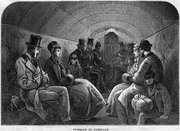Tower Subway
|
|
The Tower Subway is a tunnel beneath the River Thames in central London, close - as the name suggests - to the Tower of London. Its alignment runs between Tower Hill on the north side of the river and Vine Lane (off Tooley Street) to the south. It was the world's first underground tube railway.
| Contents |
Origins of the Tower Subway
It was designed and built by James Henry Greathead in 1869-1870 using a cylindrical wrought-iron tunnelling shield he designed with Peter W. Barlow. The entrance shaft at Tower Hill is 60' deep, while that in Vine Lane is 50' deep. The minimum distance between the top of the tunnel and the river bed is 22'.
The Tower Subway was originally intended to provide a railway service beneath the river. As such, it was the world's first underground tube railway, officially opened on 2 August 1870. A small cable car (dubbed an omnibus by the tunnel's operators) carrying 12 people shuttled passengers from end to end through a single bore, 450 yards long and 7' in diameter, on a 2' 6" track. The journey, powered by a 4HP stationary steam engine on the south side of the tunnel, took about 70 seconds. However, the cramped, low-capacity subway proved uneconomic and lasted just three months. The tunnel was subsequently converted to a pedestrian route with the cables ripped out and gas lights installed. This became a very popular way to cross the river, averaging 20,000 people a week (a million a year) at a cost of one half-penny each way.
In September 1888, the Subway briefly achieved a certain notoriety after a man brandishing a knife was seen in the tunnel at the time when Jack the Ripper was committing murders in nearby Whitechapel.
The Tower Subway was eventually superseded by Tower Bridge, which was constructed almost directly above it and opened in 1894. The Subway closed shortly afterwards for lack of custom.
Contemporary accounts of the Subway
The Subway was, from all accounts, not a good place for a claustrophobe to visit. Charles Dickens Jr. reported that
- "there is not much head-room left, and it is not advisable for any but the very briefest of Her Majesty's lieges to attempt the passage in high-heeled boots, or with a hat to which he attaches any particular value."
- (Charles Dickens Jr., Dickens's Dictionary of London, 1879)
The Italian writer Edmondo De Amicis (1846-1908) gave a vivid description of a passage through the Subway in his Jottings about London:
"As I was thinking of these things I disappeared from the world indeed, going down a lighted spiral staircase which buries itself in the earth on the right bank of the Thames, opposite the Tower. I went down and down between two dingy walls until I found myself at the round opening of the gigantic iron tube, which seems to undulate like a great intestine in the enormous belly of the river. The inside of this tube presents the appearance of a subterranean corridor, of which the end is invisible. It is lighted by a row of lights as far as you can see, which shed a veiled light, like sepulchral lamps; the atmosphere is foggy; you go along considerable stretches without meeting a soul; the walls sweat like those of an aqueduct; the floor moves under your feet like the deck of a vessel; the steps and voices of the people coming the other way give forth a cavernous sound, and are heard before you see the people, and they at a distance seem like great shadows; there is, in short, a sort of something mysterious, which without alarming causes in your heart a vague sense of disquiet. When then you have reached the middle and no longer see the end in either direction, and feel the silence of a catacomb, and know not how much farther you must go, and reflect that in the water beneath, in the obscure depths of the river, is where suicides meet death, and that over your head vessels are passing, and that if a crack should open in the wall you would not even have the time to recommend your soul to God, in that moment how lovely seems the sun!
I believe I had come a good part of a mile when I reached the opposite opening on the left bank of the Thames; I went up a staircase, the mate of the other, and came out in front of the Tower of London."
- (Edmondo de Amicis, Jottings about London (trans), 1883)
The Subway today
Tower_subway_old_entrance.jpg
From the 1920s, the tunnel gained a new purpose as a route for hydraulic tubes, operated by the London Hydraulic Power Company, and water mains. The tunnel was badly damaged by bombing during World War II. While it is no longer used for hydraulic tubes, it still carries water mains; today the hydraulic tubes, once a major source of power in the centre of London, have been replaced by telecommunication cables.
A small round entrance building still survives at Tower Hill, near the ticket office for the Tower of London. This is not the original entrance, but was built in the 1920s by the London Hydraulic Power Company. The equivalent entrance on the south bank of the Thames was reportedly demolished in the 1990s.
See also
External links
- Making History: The Tower Subway (http://www.bbc.co.uk/education/beyond/factsheets/makhist/makhist7_prog3a.shtml)
- Lost Subways: Tower Hill Subway (http://perso.club-internet.fr/fdelaitre/Ths.htm)
- Lost Industry of Southwark (http://www.lostindustry.org.uk/walktower1.htm)


